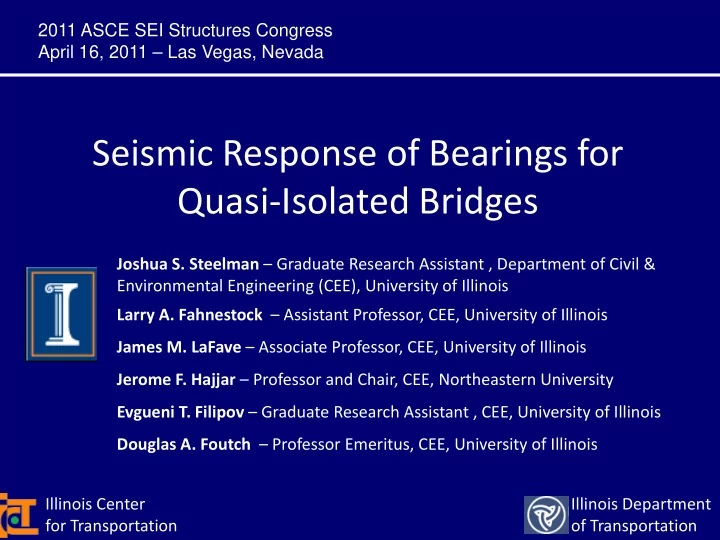

2011 ASCE SEI Structures Congress April 16, 2011 – Las Vegas, Nevada Seismic Response of Bearings for Quasi-Isolated Bridges Joshua S. Steelman – Graduate Research Assistant , Department of Civil & Environmental Engineering (CEE), University of Illinois Larry A. Fahnestock – Assistant Professor, CEE, University of Illinois James M. LaFave – Associate Professor, CEE, University of Illinois Jerome F. Hajjar – Professor and Chair, CEE, Northeastern University Evgueni T. Filipov – Graduate Research Assistant , CEE, University of Illinois Douglas A. Foutch – Professor Emeritus, CEE, University of Illinois Illinois Center Illinois Department for Transportation of Transportation
Introduction IDOT Earthquake Resisting System (ERS): Recently developed & adopted design approach tailored to typical Illinois bridge types (and in part addressing increased hazard levels in AASHTO) Primary objective: Prevention of span loss Three levels of design and performance: » Level 1: Connections between super- and sub- structures designed to provide a nominal fuse capacity » Level 2: Provide sufficient seat widths at substructures to allow for unrestrained superstructure motion » Level 3: Plastic deformations in substructure and foundation elements (where permitted) Calibration and Refinement of Illinois' Earthquake Resisting 9/24/2010 2 System Bridge Design Methodology
Experimental Testing Program Characterize behavior of unrestrained elastomeric bearings Relative importance of slip, instability, and bond of internal shims Seismic Response of Bearings 04/16/2011 3 for Quasi-Isolated Bridges
Experimental Testing Program Transverse response including retainer response at large displacements Seismic Response of Bearings 04/16/2011 4 for Quasi-Isolated Bridges
Experimental Testing Program Elastomeric bearings with Teflon sliding layer Seismic Response of Bearings 04/16/2011 5 for Quasi-Isolated Bridges
Experimental Testing Program Sequence of damage progression for fixed-bearings Seismic Response of Bearings 04/16/2011 6 for Quasi-Isolated Bridges
Experimental Testing Set-Up Concrete pad simulates substructure surface Bearing Specimen Pair of vertical actuators maintain constant vertical load with varying horizontal bearing position Horizontal Actuator Stroke = +/- 15” Seismic Response of Bearings 04/16/2011 7 for Quasi-Isolated Bridges
Experimental Observations Initial observations suggest slip is most significant influence during large earthquake Seismic Response of Bearings 04/16/2011 8 for Quasi-Isolated Bridges
Experimental Observations Initial observations suggest slip is most significant influence during large earthquake Seismic Response of Bearings 04/16/2011 9 for Quasi-Isolated Bridges
Experimental Observations Limited damage observed with repeated tests on single bearing Seismic Response of Bearings 04/16/2011 10 for Quasi-Isolated Bridges
Experimental Observations Higher compression Higher friction break- off force & larger displacement to induce slip Seismic Response of Bearings 04/16/2011 11 for Quasi-Isolated Bridges
Experimental Observations Inverse relationship between compression stress and friction limit Seismic Response of Bearings 04/16/2011 12 for Quasi-Isolated Bridges
Experimental Observations Inverse relationship between compression stress and friction limit Seismic Response of Bearings 04/16/2011 13 for Quasi-Isolated Bridges
Experimental Observations Inverse relationship between compression stress and friction limit Seismic Response of Bearings 04/16/2011 14 for Quasi-Isolated Bridges
Experimental Observations 200 psi compression 7”x12” elastomer Seismic Response of Bearings 04/16/2011 15 for Quasi-Isolated Bridges
Experimental Observations 200 psi compression 7”x12” elastomer Seismic Response of Bearings 04/16/2011 16 for Quasi-Isolated Bridges
Experimental Observations 200 psi compression 7”x12” elastomer Seismic Response of Bearings 04/16/2011 17 for Quasi-Isolated Bridges
Experimental Observations 500 psi compression 7”x12” elastomer Seismic Response of Bearings 04/16/2011 18 for Quasi-Isolated Bridges
Experimental Observations 500 psi compression 7”x12” elastomer Seismic Response of Bearings 04/16/2011 19 for Quasi-Isolated Bridges
Experimental Observations 500 psi compression 7”x12” elastomer Seismic Response of Bearings 04/16/2011 20 for Quasi-Isolated Bridges
Experimental Observations 800 psi compression 7”x12” elastomer Seismic Response of Bearings 04/16/2011 21 for Quasi-Isolated Bridges
Experimental Observations 800 psi compression 7”x12” elastomer Seismic Response of Bearings 04/16/2011 22 for Quasi-Isolated Bridges
Experimental Observations 800 psi compression 7”x12” elastomer Seismic Response of Bearings 04/16/2011 23 for Quasi-Isolated Bridges
Experimental Observations 385 psi compression 13”x20” elastomer Seismic Response of Bearings 04/16/2011 24 for Quasi-Isolated Bridges
Experimental Observations 385 psi compression 13”x20” elastomer Seismic Response of Bearings 04/16/2011 25 for Quasi-Isolated Bridges
Experimental Observations 385 psi compression 13”x20” elastomer Seismic Response of Bearings 04/16/2011 26 for Quasi-Isolated Bridges
Experimental Observations Single retainer tests Seismic Response of Bearings 04/16/2011 27 for Quasi-Isolated Bridges
Experimental Observations Single retainer tests Seismic Response of Bearings 04/16/2011 28 for Quasi-Isolated Bridges
Experimental Observations Single retainer tests Seismic Response of Bearings 04/16/2011 29 for Quasi-Isolated Bridges
Experimental Observations Small retainer test Seismic Response of Bearings 04/16/2011 30 for Quasi-Isolated Bridges
Experimental Observations Small retainer test Seismic Response of Bearings 04/16/2011 31 for Quasi-Isolated Bridges
Experimental Observations Large retainer test Seismic Response of Bearings 04/16/2011 33 for Quasi-Isolated Bridges
Experimental Observations Small vs Large retainers Seismic Response of Bearings 04/16/2011 34 for Quasi-Isolated Bridges
Experimental Observations Small vs Large retainers Seismic Response of Bearings 04/16/2011 35 for Quasi-Isolated Bridges
Conclusions Type I bearings shown to be remarkably resilient Stable friction hysteresis with multiple fully reversed cycles Visible abrasions at friction interface Scragging and deterioration have minor effect on performance Type I bearings tolerate approx. 100 – 200% equivalent shear strain without slip Proportionately related to compression load Friction break-off coefficient approx. 0.25 – 0.5 Inversely related to compression load Retainer fuse strength currently significantly underestimated Capacity closer to ultimate tensile strength of anchor, instead of shear or combined shear & tension strength Underestimation more severe for smaller anchors Seismic Response of Bearings 04/16/2011 36 for Quasi-Isolated Bridges
Recommend
More recommend